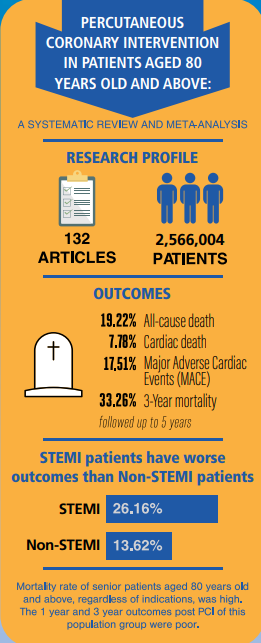To Balloon Or Not To Balloon?
Meta-analysis research sheds light on PCI
treatment risks in older patients
PULSE Issue 41 | July 2023
Time is often of the essence when treating Myocardial Infarctions (MI), also known
as heart attacks. Every minute after a heart attack, more heart tissue is damaged
or dies, causing irreversible injury to the heart.
One of the key life-saving procedures used to treat heart attacks is Percutaneous
Coronary Intervention (PCI), also commonly known as “stenting” or “ballooning”.
This procedure is minimally invasive whereby a catheter is inserted into one of
the arteries through just a small incision. Once the catheter is in place, a thin wire
delivers a small balloon to the artery narrowed with cholesterol deposits, and the
balloon inflates to widen the passageway in order to restore blood flow to the
heart muscles. Sometimes, a stent is also left in place when the balloon is removed
to continue keeping the artery open.
 However, such procedures come with inherent risks. With increasing age, frailty,
and multiple diseases, senior patients aged 80 and above who undergo PCI are at
a higher risk of mortality and other complications.
Therefore, NUHCS researchers conducted a systematic review and meta-analysis to
evaluate the clinical outcomes of patients aged 80 and above who underwent PCI.
The team combined data from 132 research articles across 33 regions for this study.
They found that the mortality rate of patients aged 80 and above who underwent
PCI was 19.2%, of which 7.8% died due to cardiac reasons. 7.2% of these patients
did not survive the hospital admission. The mortality rate increases to 14.7% when
followed up for a year, and increases further to 33.3% after three years. Overall,
17.5% will experience a major adverse cardiovascular event such as heart failure,
stroke, or heart attack after undergoing a PCI procedure.
These outcomes were worse for patients with ST-Elevation Myocardial Infarction
(STEMI) – a type of heart attack that is caused by a complete blockage in one of
the major coronary blood vessels.
However, such procedures come with inherent risks. With increasing age, frailty,
and multiple diseases, senior patients aged 80 and above who undergo PCI are at
a higher risk of mortality and other complications.
Therefore, NUHCS researchers conducted a systematic review and meta-analysis to
evaluate the clinical outcomes of patients aged 80 and above who underwent PCI.
The team combined data from 132 research articles across 33 regions for this study.
They found that the mortality rate of patients aged 80 and above who underwent
PCI was 19.2%, of which 7.8% died due to cardiac reasons. 7.2% of these patients
did not survive the hospital admission. The mortality rate increases to 14.7% when
followed up for a year, and increases further to 33.3% after three years. Overall,
17.5% will experience a major adverse cardiovascular event such as heart failure,
stroke, or heart attack after undergoing a PCI procedure.
These outcomes were worse for patients with ST-Elevation Myocardial Infarction
(STEMI) – a type of heart attack that is caused by a complete blockage in one of
the major coronary blood vessels.
Patients with STEMI have an even higher mortality rate (23.1%) and an in-hospital death rate (14.2%).
The researchers attribute this to elderly patients’ underlying health issues such as
chronic diseases which leave them with poorer reserves and thus more vulnerable
to various stressors from their underlying illnesses.
Although older patients face significantly higher risks in undergoing PCI, the evidence still supports the need for the procedure, especially for those with unstable
coronary artery diseases.
With greater clarity from this study, clinicians are now in a position to better advise patients on the considerations in proceeding with a PCI, as a treatment
method for their heart condition.
This study also highlights the gap in care for older patients. The mortality rate for
elderly patients undergoing PCI after heart attacks is still unacceptably high, hence
more research still needs to be done to look into strategies to mitigate these risks.
These findings build on the ongoing collaboration by NUHCS and experts in geriatric medicine to find better strategies for mitigating the high risks faced by older
patients undergoing PCI.
